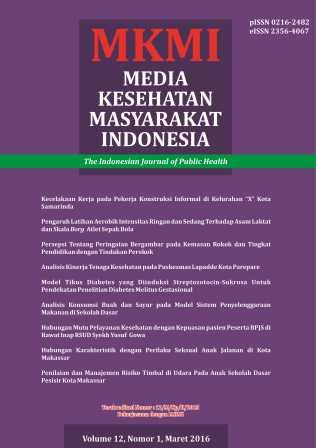ANALISIS KONSUMSI BUAH DAN SAYUR PADA MODEL SISTEM PENYELENGGARAAN MAKANAN DI SEKOLAH DASAR
Abstract
References
Depkes RI. Rancangan Final Rencana Pembangunan Jangka Panjang Bidang Kesehatan 2005 – 2025. Jakarta : Departemen Kesehatan RI; 2009.
Depag. Pedoman Pelaksanaan Penyediaan Makanan Tambahan Anak Sekolah (PMT-AS) Bagi Siswa RA dan MI Tahun 2012. Jakarta : Direktorat Pendidikan Madrasah Ditjen Pendidikan Islam Kementrian Agama Republik Indonesia; 2012.
Depkes RI. Pedoman Gizi Seimbang 2014. Jakarta: Departemen Kesehatan RI; 2014.
Acham, H, Kikafunda, JK, Malde, MK, Oldewage- Theron, WH, Egal, AA. Breakfast, midday meals and academic achievement in rural primary schools in Uganda: implications for education and school health policy. Food and Nutrition Research. 2012; 56(11217): 1-12.
Nkhoma, OWW, Duffy, ME, Cory-Slechta, DA, Davidson, PW, McSorley, EM, Strain, J, J & O’Brien, GM . Early-stage primary school children attending a school in the Malawian school feeding program have better reversal learning and lean muscle mass growth than those attending a non-sfp school. The Journal of Nutrition. 2013; 143: 1324-1330.
Uwameiye, BE and Salami, LI. Assesment of the UNICEF supported school feeding programme on attendance of pupils in federal capital territory. International Journal of Academic Research in Progressive Education and Development. 2013;2(1):2226-6348.
Ishida H. Role of school meal service in nutrition. J Nutr Sci Vitaminol. 2015;61:S20-S22.
Woo T. School meal system and school based nutrition education in Korea. Symposium in Yokohama, Japan. 12th Asian Congress of Nutrition; 14-18 May 2015; Yokohama, Japan: Japan Society of Nutrition and Food Science, Science Council of Japan; 2015.
Sinaga, T, Kusharto, CM, Setiawan, B dan Sulaeman, A. Dampak menu sepinggan terhadap konsumsi dan tingkat kecukupan energi serta zat gizi lain pada siswa SD. J Gizi Pangan. 2012; 7(1): 27-34.
Balitbangkes. Riset Kesehatan Dasar 2010. Jakarta: Kementerian Kesehatan RI; 2010.
Balitbangkes. Riset Kesehatan Dasar 2013. Jakarta: Kementerian Kesehatan Republik Indonesia; 2013.
Balitbangkes. Riset Kesehatan Dasar 2007. Jakarta: Kementerian Kesehatan Republik Indonesia; 2007.
Mohammad, A dan Madanijah, S. Konsumsi buah dan sayur anak usia sekolah dasar di Bogor. Jurnal Gizi Pangan. 2015;10(1):71-76..
WHO/FAO. Report of a Joint WHO/FAO Expert Consultation: Diet, Nutrition, and the Prevention of Chronic Disease Geneva. Geneva: WHO; 2003.
Sartika, RAD. Faktor Risiko Obesitas pada Anak 5-15 Tahun di Indonesia. Makara Kesehatan. 2011; 15(1): 37-43.
Kelishadi, R and Azizi-Soleiman, F. Controlling childhood obesity: A systematic review on strategies and challenges. J Res Med Sci. 2014; 19:993-1008.
Yulni, Hadju, V dan Virani, D. Hubungan asupan zat gizi makro dengan status gizi pada anak sekolah dasar di wilayah pesisir kota Makassar tahun 2013. MKMI [Online Journal] 2013; 1-12 [diakses 10 September 2015]. Available at: http://repository.unhas.ac.id/bitstream/handle/123456789/5823/jurnal%20
mkmi%20yulni.pdf?sequence=1.
Lazzeri, G, Pammoli, A, Azzolini, E, Simi, R, Meoni, V, de Wet, DR & Giacchi MV. Association between fruits and vegetables intake and frequency of breakfast and snacks consumption: a cross-sectional study. Nutrition Journal. 2013; 12:123.
Miller, N, Reicks, M, Redden, JP, Mann, T, Mykerezi, E & Vickers Z. Increasing portion sizes of fruits and vegetables in an elementary school lunch program can increase fruit and vegetable consumption. Appetite [Online Journal] 2015; 91:426–430 [diakses 10 November 2015]. Available at: http://dx.doi.org/10.1016/j.appet.2015.04.081.
Pertiwi, KI, Hardinsyah dan Ekawidyani, KR. Konsumsi pangan dan gizi serta skor pola pangan harapan pada anak usia sekolah 7-12 tahun di Indonesia. Jurnal Gizi Pangan. 2014; 9(2): 117-124.
Agustina, W, Jus’at, I, Mulyani. EY, dan Kuswari, M. Asupan Zat Gizi Makro Dan Serat Menurut Status Gizi Anak Usia 6-12 Tahun Di Pulau Sulawesi. Jurnal Gizi Pangan. 2015;10(1): 63-70.
Authors
Authors retain copyright and grant the journal right of first publication with the work simultaneously licensed under a Creative Commons Atribusi-NonKomersial-BerbagiSerupa 4.0 Internasional License that allows others to share the work with an acknowledgement of the work's authorship and initial publication in this journal.
Copyright encompasses rights to reproduce and deliver the article in all form and media, including reprints, photographs, microfilms and any other similar reproductions, as well as translations. The reproduction of any part of this journal, its storage in databases and its transmission by any form or media, such as electronic, electrostatic and mechanical copies, photocopies, recordings, magnetic media, etc.
All articles published Open Access are free for everyone to read and download. Under the CC-BY-NC-SA license, authors retain ownership of the copyright for their article, but authors grant others permission to use the content of publications in Media Kesehatan Masyarakat Indonesia Universitas Hasanuddin in whole or in part provided that the original work is properly cited. Users (redistributors) of Media Kesehatan Masyarakat Indonesia Universitas Hasanuddin are required to cite the original source, including the author's names, Media Kesehatan Masyarakat Indonesia Universitas Hasanuddin as the initial source of publication, year of publication, and volume number.
Media Kesehatan Masyarakat Indonesia Universitas Hasanuddin is licensed under Creative Commons Atribusi-NonKomersial-BerbagiSerupa 4.0 Internasional.


